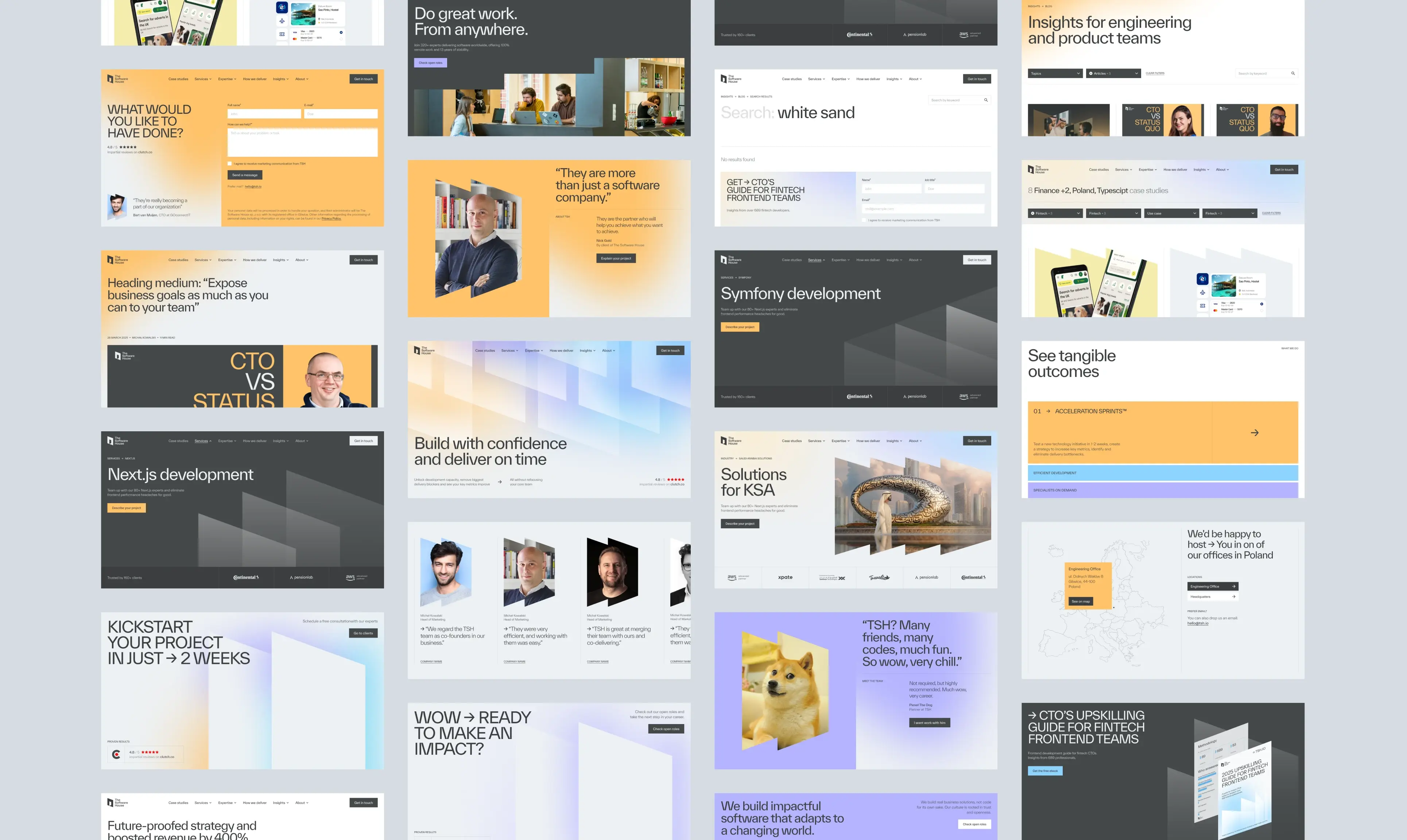You already have a working product that brings in revenue and inspires you to evolve and scale your business. You probably have dozens of ideas about what the next steps should be. One of the main points of the roadmaps we create for clients is UX – improving UX and making that app’s UX great. Yet, clients are a little bit surprised when we say that, as UX specialists, we suggest taking actions other than drawing the following design concepts over and over again.
From the ~300 UX projects we’ve completed, we’ve learned that some actions you can take inside of your organization before starting cooperation with a design agency. Of course, we can always help you from the get – go, but it never hurts to show up having done some homework.
Improved data insights – install analytics
From the beginning of every collaboration, we ask questions about goals, user feedback, and the model of cooperation. One of the crucial questions that inevitably comes up is about analytics and getting our team access to that data.
We suggest installing essential analytics tools, like Google Analytics and other tools for click tracking, even if there aren’t many insights from the start. It takes time for early–stage start–ups to start seeing an uptake in traffic, and collect enough data to make analyses. But, without any analytics, we don’t even know whether anyone has visited your website or a certain landing page.
Analytics tools installed early on are not just collecting data for the sake of collecting data. In the future, you’ll be able to see historical trends and changes from the start of a product to its maturity.

Utilize session recordings and heatmaps
Quantitative data, like that collected in Google Analytics, is an excellent source of information to find out what’s happening in your product, and track user behaviors. For example, if users are leaving your registration at the second step, or if users are spending most of their time on the dashboard view.
Unfortunately, this quantitative data doesn’t explain why users are behaving the way they do.
In a perfect world, we would just ask users in person – but we can’t always do that for each and every doubtful detail. However, there are some quick alternatives, like session recording tools, that can help us to understand what’s happening in the mind of your users.
Popular apps like Hotjar, Fullstory, Posthog follow mouse events, which means we can reproduce user flows as videos. We can then step into our users’ shoes and see where they’re struggling the most and which part of the view annoyed them enough that they left. This type of tools provide important insights and generate heatmaps, allowing for faster analysis.
Rethink your digital product strategy (as a team)
As a CEO or CTO, you know the ins and outs of your business – all the strengths and weaknesses. Yet, during the discovery workshops, we’ve found that 3 out of 5 clients with existing products realized that there were some elements of their business concept that they weren’t totally sure of.
During these discovery workshops, we start from a Lean Canvas. This is a one – page business model with all the details needed to get everyone on the same page and provide enough context to kickoff.

Another interesting observation we made is that this exercise is extremely valuable for client teams, including developers. Employees in a company change from time to time, particularly in startups. Not everyone receives the same level of onboarding.
We’ve experienced situations where there were developers who struggled to understand what the product did and the strategy for monetizing it. They were not given enough information to fully grasp how this product benefited users or how it brought in revenue.
A Lean Canvas is great for ensuring your whole team understands the big picture while also being a wonderful tool for our visual designers to gather the key assumptions about the product.
Designers and developers need to know:
- who the target audience is,
- what the app's strengths are,
- what elements to play down,
- and who the competitors are.
All of these have crucial impacts on design. A perfect example of this would be a financial dashboard for both a financial expert and someone who manages a small company.
A financial dashboard for a financial expert can be a more crowded screen with various details and numbers everywhere.
A financial dashboard for someone managing a small company should be cleaner, organized into sections or pages that reveal data details as needed or requested by the user.
Displaying everything in small fonts and with little spacing would be more suitable for the financial expert, but is not the best visual representation of data for the small company manager.

Gather product feedback through user interviews
Conducting user interviews should be done once or twice a year, at least. You will be surprised by how valuable these interviews can be. This doesn’t need to be time–consuming, nor should it break your bank.
At Widelab, you can get results from user interviews within a few days. You can also use apps with a large base of testers, like PlayBookUX or UserInterviews.com.
User testing helps you with your existing product by allowing you to: check that your roadmap and feature prioritizations make sense, identify weak points in the app, and determine which sections to redesign, test designs and ideas for features and changes.
Regarding testing designs and ideas, you will save money spent on development later. All changes mean costs. You can test each idea and approach it as an investment rather than uncalculated risks that throw money down the drain.

Maybe it's time for a mobile version
Current trends lean towards mobile, particularly mobile–first. If your app isn’t desktop specific, like a complex financial app, or a designing app like Figma, sooner or later you will need a portable version that utilizes, at the least, your product’s more crucial features.
People are looking to do more work on the go, whether it’s from the comfort of their couch, or while taking public transit on their way to the office.
If you don’t have a mobile version of your product, you can use Google Analytics to see how important mobile is for your user base. Is 14% or 77% of your product’s traffic coming from mobile devices? The higher number means a greater need for your product to have a mobile option.
If you’re finding that the major part of your traffic is coming from users on mobile devices, it likely means that you should think about mobile solutions and flows first, before concerning yourself with desktop ones.

Revisit user onboarding
The onboarding process of your product will determine if and how your business will grow. We repeatedly receive requests from clients who are struggling with their user onboarding.
The greatest challenge here is finding out exactly why users are leaving at a certain step. To answer that you:
- Need analytics to define where there are potential gaps and dropouts.
- Should take some session recordings to investigate possible reasons.
- Must ask users for their opinions directly via either user testing or your customer service team.
General UX and interactions
It’s important to note that the reasons that many users leave onboarding processes are varied. Users can be frustrated by how inconvenient the app is. Instead of complex onboarding with explanations for each action, improving the UX of features can be more impactful than reworking the whole onboarding process.
Time and doubts
Uncertainty about how long it takes or questions during the process. Users drop off when onboarding is taking a long time or they’re unsure about certain steps. Designing a progress bar with explanations of specific features can be a great way to reassure users.
Value proposition
Perhaps the problem isn’t the onboarding. Maybe the value proposition on the website is misleading, so when users create accounts, they leave when they see that this isn’t the right product for them. Being clear about what your users gain from your product, from the get–go, is crucial.

Make sure your design system is logical
If the links in your app are all different colors, and you have varying background colors and fonts, it means your design has no logic. This also means that every new feature you add will create more of a mess for both your app and code.
The ultimate reality here is that you can slow scalability and burn UX because users can’t anticipate what specific button styles mean or what is clickable. You’ll not only be confusing your users but your developers too. Each new design brings in new lines of code within your CSS, making it more difficult to keep the code clean and create consistency.
We suggest getting an audit of your app styles and design system creation, especially in cases when there is clearly no harmony within the visuals of your product. We offer complex design systems or more straightforward style guides, depending on your needs. You can read more about it here.







